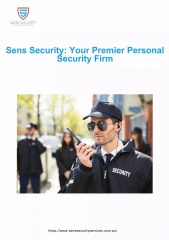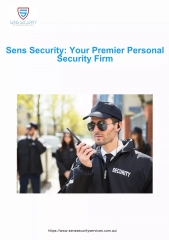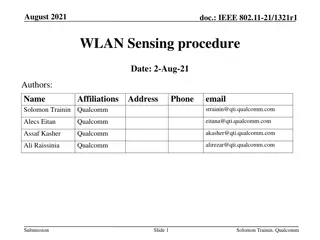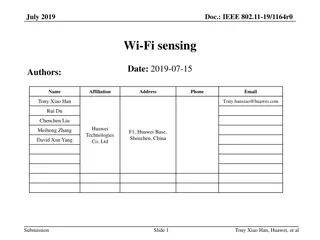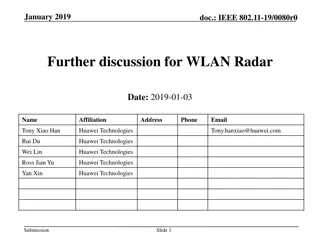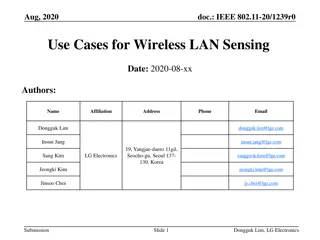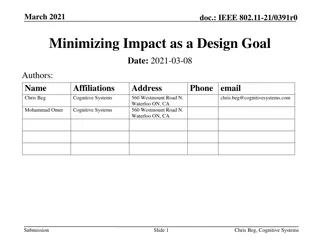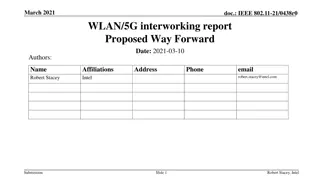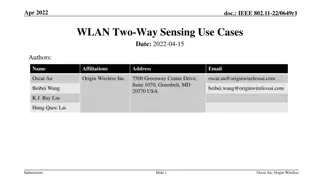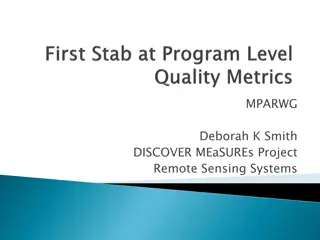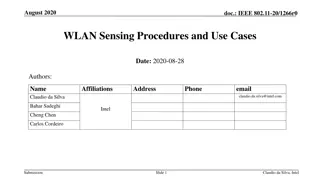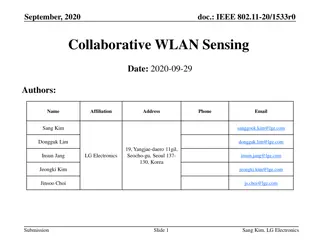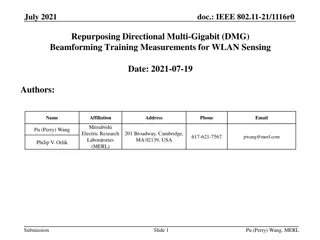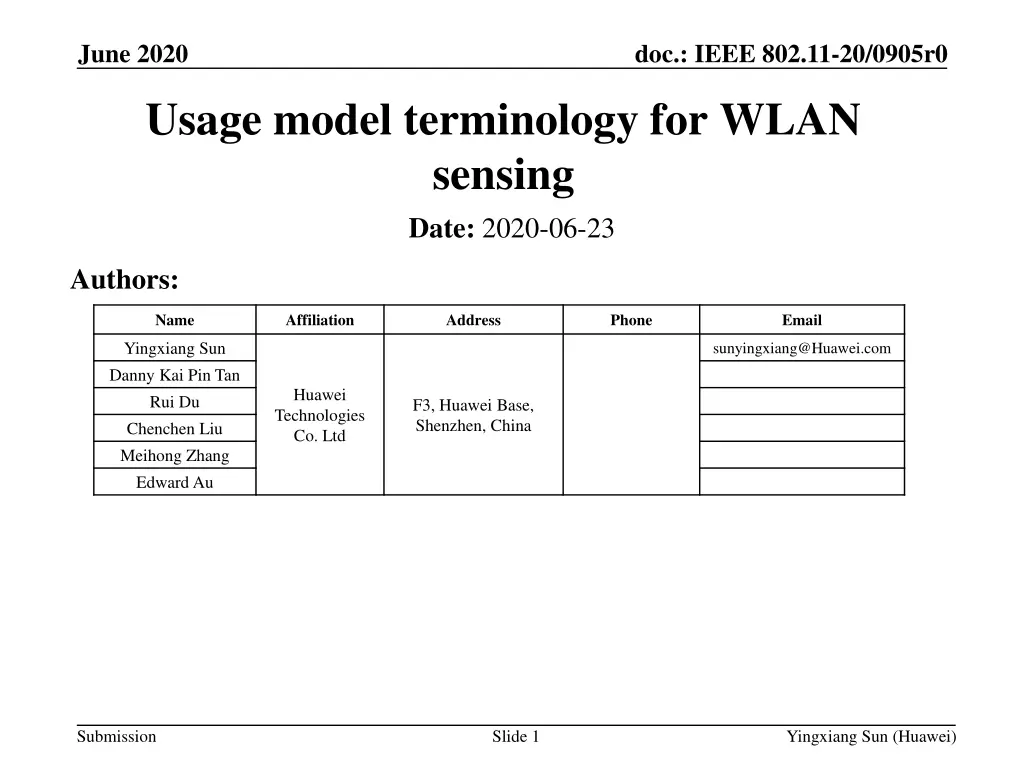
IEEE 802.11-20/0905r0 WLAN Sensing Usage Model Terminology Refresh
Explore the updated usage model terminology for WLAN sensing in the IEEE 802.11-20/0905r0 document. Discover key metrics, such as range coverage, resolution, and accuracy, essential for discussing requirements in WLAN sensing applications.
Download Presentation

Please find below an Image/Link to download the presentation.
The content on the website is provided AS IS for your information and personal use only. It may not be sold, licensed, or shared on other websites without obtaining consent from the author. If you encounter any issues during the download, it is possible that the publisher has removed the file from their server.
You are allowed to download the files provided on this website for personal or commercial use, subject to the condition that they are used lawfully. All files are the property of their respective owners.
The content on the website is provided AS IS for your information and personal use only. It may not be sold, licensed, or shared on other websites without obtaining consent from the author.
E N D
Presentation Transcript
June 2020 doc.: IEEE 802.11-20/0905r0 Usage model terminology for WLAN sensing Date: 2020-06-23 Authors: Name Affiliation Address Phone Email Yingxiang Sun Danny Kai Pin Tan Rui Du Chenchen Liu Meihong Zhang Edward Au sunyingxiang@Huawei.com Huawei Technologies Co. Ltd F3, Huawei Base, Shenzhen, China Submission Slide 1 Yingxiang Sun (Huawei)
June 2020 doc.: IEEE 802.11-20/0905r0 Abstract The purpose of this contribution is to serve as a starting point in preparing an usage model document for the future SENS TG. Specifically, this contribution refreshes the usage model terminology the other TGs are using in preparing the respective usage model documents, proposes a few metrics that would facilitate the discussion on requirements for WLAN sensing, and provides an illustrative example on an usage model with the proposed metrics. Submission Slide 2 Yingxiang Sun (Huawei)
June 2020 doc.: IEEE 802.11-20/0905r0 Refresh: Usage model terminology Submission Slide 3 Yingxiang Sun (Huawei)
June 2020 doc.: IEEE 802.11-20/0905r0 Usage model terminology Usage Model A usage model is the combination of the following 4 items below; not to be confused with a use case which is the specific set of steps to accomplish a particular task. Pre-Conditions Initial conditions before the use case begins. Environment The type of place in which the network of the use case is deployed, such as home, outdoor, hot spot, enterprise, metropolitan area, etc. Use case A use case is task oriented. It describes the specific step-by-step actions performed by a user or device. One use case example is a user starting and stopping a video stream. Requirement and attribute The evaluated performance with specific metrics that are expected to achieve in the use case. NOTE: In the usage model documents of other TGs, Applications and TrafficModels may be included. Based on the nature of this project, we do not believe these two items are needed. Instead, a new item Requirement and attribute is proposed. Submission Slide 4 Yingxiang Sun (Huawei)
June 2020 doc.: IEEE 802.11-20/0905r0 Proposed metrics for discussion on requirements for WLAN sensing Submission Slide 5 Yingxiang Sun (Huawei)
June 2020 doc.: IEEE 802.11-20/0905r0 Proposed metrics & the respective definitions (1) Range Coverage: The maximum allowable distance from a sensing device to the target. The SNR is above a pre-defined threshold (conventionally taken as 10dB or 13dB) within this distance, which enables targets to be detected. E.g., < 5m@13dB would indicate that the maximum allowable distance from a sensing device to the target with a 13dB SNR threshold is within 5 meters. Range Resolution: The ability of sensing device to distinguish between two or more targets on the same direction but at different ranges. E.g., 50cm would indicate that two targets are distinguishable when the range difference between them is greater than 50cm. Range Accuracy: The difference between the estimated range and the actual range of an object. E.g., 10cm is a requirement that the estimated range be within 10cm of the actual range. https://polarresearch.net/index.php/polar/article/view/3382/10009#figures Submission Slide 6 Yingxiang Sun (Huawei)
June 2020 doc.: IEEE 802.11-20/0905r0 Proposed metrics & the respective definitions (2) Angular Resolution (Horizontal / Vertical): The minimum angle between two targets at the same range which sensing device is able to distinguish and separate from each other. E.g., 10 would indicate that two targets with an angle between them that values greater than 10 are distinguishable. Angular Accuracy (Horizontal / Vertical): The difference between the estimated angle and the actual angle of an object. E.g., 1 is a requirement that the estimated angle be within 1 of the actual angle. Submission Slide 7 Yingxiang Sun (Huawei)
June 2020 doc.: IEEE 802.11-20/0905r0 Proposed metrics & the respective definitions (3) Velocity Resolution: The minimal radial velocity difference between two objects travelling at the same range before a sensing device detects two discrete reflections. E.g., 0.1m/s would indicate that two or more targets that with velocity difference greater than 0.1m/s between each other are distinguishable. Velocity Accuracy: The difference between the estimated velocity and the actual velocity of an object. E.g., 0.2m/s is a requirement that the estimated velocity be within 0.2m/s of the actual velocity. Submission Slide 8 Yingxiang Sun (Huawei)
June 2020 doc.: IEEE 802.11-20/0905r0 Proposed metrics & the respective definitions (4) Probability of Detection: The ratio of number of correct predictions to the number of all aimed samples in terms of gestures/activities/motions, which, e.g., can be one of the followings: a) gesture detection where a pre-defined set of gestures and/or motions shall be identified; b) presence detection; c) a specific body activity detection like breathing; d) real person detection distinguishing human beings from other objects. E.g., >95% is a requirement that the percentage of correct detection is more than 95%. Submission Slide 9 Yingxiang Sun (Huawei)
June 2020 doc.: IEEE 802.11-20/0905r0 Proposed metrics & the respective definitions (5) Field of View (FOV): The angle through which the sensing device performs sensing, i.e., the FOV indicates the coverage area of a sensing device in terms of angle. E.g., 50 is a requirement that the coverage area of a sensing device is 50 . Latency: Expected time taken to finish the related WLAN sensing process. E.g., 10 ms latency would indicate that WLAN sensing process needs to be completed within 10 ms. Refresh Rate: This defines how frequent the refresh takes place. E.g., a refresh rate of 10 Hz would indicate that WLAN sensing results need to be refreshed 10 times in a second. Number of Simultaneous Targets: This defines how many targets could be detected simultaneously within the sensing area. E.g., a simultaneous targets number of 5 would indicate that 5 targets could be detected/localized/tracked/ simultaneously by WLAN sensing device within the sensing area. Submission Slide 10 Yingxiang Sun (Huawei)
June 2020 Proposed metrics & the respective definitions (6) doc.: IEEE 802.11-20/0905r0 Summary of proposed metrics The proposed metrics can be grouped into 4 different categories. Coverage Resolution Accuracy Other performance Field of view ( ) Probability of detection (%) No. of simultaneous targets Range (m) Range (m) Angle ( ) Velocity (m/s) Range (m) Angle ( ) Velocity (m/s) Latency (ms) Refresh rate (Hz) Submission Slide 11 Yingxiang Sun (Huawei)
June 2020 doc.: IEEE 802.11-20/0905r0 An example usage model Submission Slide 12 Yingxiang Sun (Huawei)
June 2020 1. Audio with user tracking (Follow-me sound) (1/2) doc.: IEEE 802.11-20/0905r0 Pre-Conditions WLAN based audio system including various WLAN speakers. WLAN is employed for sensing/positioning, but may or may not be employed for sound transfer. Audio system calibration is done, i.e., speaker placement and position determined, and audio system adjusts the speaker settings for best sound experience. Environment Smart home with 802.11 coverage and mono- static/bi-static/multi-static architecture. Immersive gaming room with 802.11 coverage and mono-static/bi-static/multi-static architecture. is automatically Use Case 1. The user does not need to wear a WLAN device. 2. The user s position is continuously monitored. 3. The audio system adjusts the speaker settings according to the user s position and movement for immersive sound experience. https://uppic-fd.zol-img.com.cn/g5/M00/0D/0A/ChMkJllWFZuIdf9SAAOoPtMQwRcAAdx4w F6HpAAA6hW306.jpg Note: This usage model is modified based on the usage model No.2 for 11az [1], which require the user to wear a WLAN device. Submission Slide 13 Yingxiang Sun (Huawei)
June 2020 1. Audio with user tracking (Follow-me sound) (2/2) doc.: IEEE 802.11-20/0905r0 Requirement and attribute Coverage Resolution Accuracy Other performance Usage model # Field of view ( ) Probability of detection (%) No. of simultaneous targets Range (m) Range (m) Angle ( ) Velocity (m/s) Range (m) Angle ( ) Velocity (m/s) Latency (ms) Refresh rate (Hz) 1. Audio with user tracking <10 @13dB 60 0.1 2 0.05 0.05 0.5 0.01 >95 <10 >10 <= 5 Submission Slide 14 Yingxiang Sun (Huawei)
June 2020 doc.: IEEE 802.11-20/0905r0 Summary Relevant terminologies required to describe the usage models for WLAN sensing have been defined. An example usage model is presented and additional usage models are expected to be added in the future. Submission Slide 15 Yingxiang Sun (Huawei)
June 2020 doc.: IEEE 802.11-20/0905r0 References [1] 11-16-0137-04-00az-ngp-use-case-document.pptx Submission Slide 16 Yingxiang Sun (Huawei)
June 2020 doc.: IEEE 802.11-20/0905r0 SP 1 Do you agree that the document of usage model should be considered and prepared for SENS SG (or the future TG), in order to facilitate the development of draft amendment? Yes: No: Abstain: Submission Slide 17 Yingxiang Sun (Huawei)


